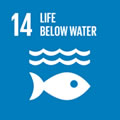Por favor, use este identificador para citar o enlazar a este item:
http://hdl.handle.net/10261/213969COMPARTIR / EXPORTAR:
 SHARE SHARE
 CORE
BASE CORE
BASE
|
|
| Visualizar otros formatos: MARC | Dublin Core | RDF | ORE | MODS | METS | DIDL | DATACITE | |

| Título: | Modeling the spatiotemporal distribution of the deep-sea shrimp Aristeus antennatus (Crustacea: Decapoda) on the northwestern Mediterranean continental margin crossed by submarine canyons |
Autor: | Clavel-Henry, Morane CSIC ORCID; Bahamon, Nixon CSIC ORCID ; Solé, Jordi CSIC ORCID ; Gorelli, Giulia CSIC ORCID; García, José A. CSIC ORCID ; Carretón, Marta CSIC ORCID ; Rotllant, Guiomar CSIC ORCID CVN ; Company, Joan B. CSIC ORCID | Palabras clave: | Fisheries, submarine canyons Mediterranean Sea Marine environments Species distribution models CPUE |
Fecha de publicación: | sep-2020 | Editor: | Elsevier | Citación: | Journal of Marine Systems 209: 103372 (2020) | Resumen: | Submarine canyons aggregate numerous marine species and can affect the structure of benthic communities. However, analyses dedicated to assess the spatial distribution variability among several canyons are rare. In the northwestern Mediterranean Sea, three major submarine canyons consecutively indent the narrow margin. There,theabundanceofdeep-seablueandredshrimpAristeusantennatus(Crustacea:Decapoda),oneofthemost important fishery-targeted species in the western and central Mediterranean Sea, sustains relatively high incomes for the nearest fishing harbors. To date, the spatial distribution of this shrimp species has only been assessed on known fishing grounds, but it has neither been modeled simultaneously covering several submarine canyons nor according to the environmental conditions. In this study, we aimed to look over the spatiotemporal shrimp distribution in a region of the northwestern Mediterranean Sea with a particular interest in variations in the three submarine canyons. From summer landing data between 2005 and 2014, we implemented a species distribution model with georeferenced catches linked to environmental data of the shrimp habitats. The model showed that the bottom topography was one of the most essential variables to explain the spatial distribution of the catches and that the highest catch rates were between 475 m and 575 m depth. Overall, two canyons (Blanes and Palamós) sheltered high estimates of catches on the shallow and narrow part of their margins (at 510 and 565 mdepth). Amongthem, 60%ofestimatedsummercatchescamefromthePalamósCanyon, butthisestimate shifted to the Blanes Canyon in summer 2008, probably due to variations in fishing fleet behavior. Modeled hypothetical temperature changes scenarios (to 1 °C warmer than the average) suggested the shrimp catches would decrease lessinthe BlanesCanyon (3% fewercatchesthan the average) than inthePalamós Canyon (20% fewer catches than the average). The information produced by the species distribution model allowed setting spawning locations and depths, which is useful to better understand the canyon influence on benthic communities and to parameterize larval transport models. | Descripción: | Este artículo contiene 9 páginas, 9 figuras, 2 tablas. | Versión del editor: | https://doi.org/10.1016/j.jmarsys.2020.103372 | URI: | http://hdl.handle.net/10261/213969 | DOI: | 10.1016/j.jmarsys.2020.103372 | ISSN: | 0924-7963 | E-ISSN: | 1879-1573 |
| Aparece en las colecciones: | (CEAB) Artículos (ICM) Artículos |
Ficheros en este ítem:
| Fichero | Descripción | Tamaño | Formato | |
|---|---|---|---|---|
| Clavel_et_al_2020_preprint.pdf | 1,48 MB | Adobe PDF |  Visualizar/Abrir | |
| Clavel_et_al_2020_suppl.pdf | 705,82 kB | Adobe PDF |  Visualizar/Abrir |
CORE Recommender
SCOPUSTM
Citations
4
checked on 22-abr-2024
WEB OF SCIENCETM
Citations
3
checked on 25-feb-2024
Page view(s)
262
checked on 24-abr-2024
Download(s)
285
checked on 24-abr-2024
Google ScholarTM
Check
Altmetric
Altmetric
NOTA: Los ítems de Digital.CSIC están protegidos por copyright, con todos los derechos reservados, a menos que se indique lo contrario.


